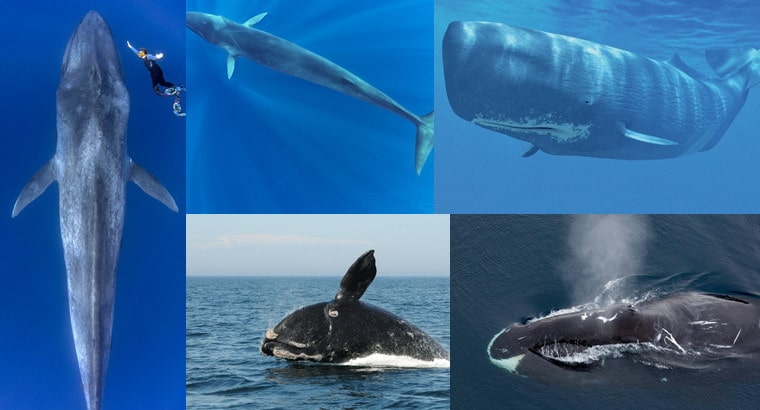If you’ve seen a full-grown blue whale, then you had the privilege of witnessing the largest animal on earth. An adult blue whale is larger than any dinosaur you’ll ever find on display in any museum. But the blue whale is not the only large whale; there are several other types of gigantic whales. This article offers you a list of the 5 largest whales in the world.
Why Are Blue Whales the Largest Animals in the World?
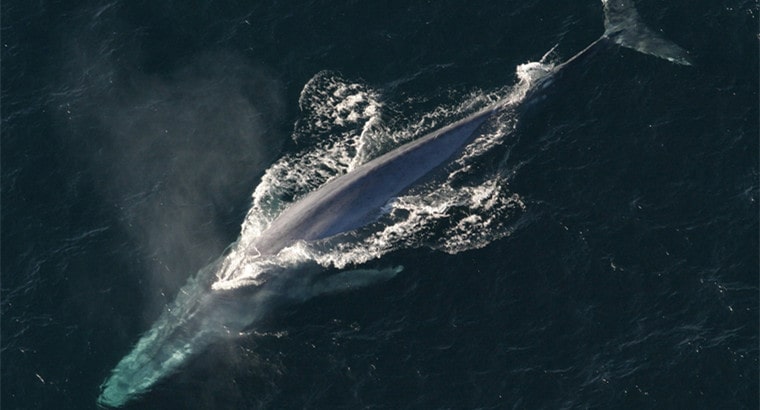
Imagine seeing a 10-story-tall beast swimming by your boat on a beautiful sunny morning. Perhaps you may think such scenes can only exist in horror movies. But this is a common occurrence in the deep seas where blue whales dwell. Also referred to as Balaenoptera musculus, the blue whale is a fascinating creature that lives in solitude.
Previously, this whale existed in almost every ocean on earth, but the indiscriminate hunting by whalers has driven its population down almost to a point of extermination. Thankfully, the hunting of blue whales was criminalized by the International Whaling Commission in 1996. In 2018, the International Union for Conservation of Nature listed this whale as endangered.
However, blue whales continue to face many threats, both natural and man-made, including pollution, climate change, noise, ship strikes, and predation. Here are some important aspects of the blue whale that prove it’s the largest animal on earth.
1. Grows More Than 100 Feet Tall
The average length of a mature blue whale is between 80 and 100 feet (25-30 meters). The longest ever recorded blue whale was 108 feet long (33 meters). This is equal to three school buses in a row.
2. Weighs More Than Three Mature Elephants
A blue whale weighs about 300,000 pounds (136,000 kilograms). This is an average of 150 tons. However, some mature blue whales can weigh up to 441,000 pounds (220 tons). For purposes of clarity, a mature African elephant weighs about 6 tons, so it’ll take more than 30 mature elephants to equal the weight of a single blue whale.
3. Gigantic Heart
A blue whale has the largest heart in the animal realm. Its heart weighs approximately 180 kg (400 pounds). It equals the size of a small car. Studies have shown that the heart of a blue whale beats only twice per minute when the beast dives to feed.
4. Big Tongue
The tongue of a mature blue whale is estimated to weigh as much as a mature African elephant.
5. Big Calves
Blue whales give birth to the largest calves in the animal realm. At birth, a whale calf ranks among the largest mammals on earth. Most whale calves weigh about 8,800 pounds at birth with a length of about 26 feet. As they grow, these calves can put on about 200 pounds every day.
6. Loudest Animal
Blue whales are the loudest animals on earth. While the sound of a jet engine is estimated to be 140 decibels, the call of a mature blue whale can reach 188 decibels. This whale usually pulses, moans, and groans. These calls can be heard from 1,000 miles away.
7. Large Meals
A blue whale’s main diet is krill. Its stomach holds up to 2,200 pounds of krill at a time. The animal requires about 9,000 pounds of krill daily. In the summer feeding season, this whale can consume about 40 million krill daily.
8. Fast Travelling Speed
A blue whale travels a lot, spending its summer feeding seasons in polar areas. As the winter approaches, it travels long distances to the equator. Although its standard traveling speed is 5 mph (8kph), it can speed up to 20 mph (32kph).
Where to Find the Largest Whales in the World
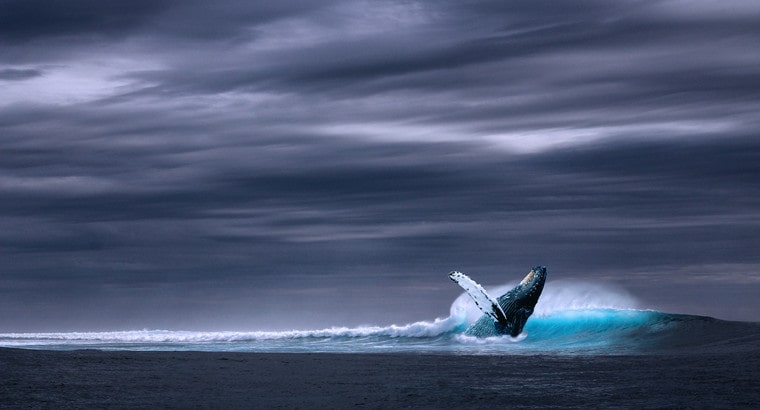
If you are fascinated by the whale’s social dynamics, acumen, and powerful presence, there are many places where you will the largest whales in abundance. Here are the common places to find the largest whales in the world.
1. Tysfjord, Norway
The start of the Arctic winter corresponds with the intense feeding season for whales in Norway. Therefore, you can find pods of hungry killer whales along the coast of Andenes in the Vesteralen archipelago.
2. Cape Breton, Canada
In summer, the chilly waters in the north of Nova Scotia’s Cape Breton become the playground for different types of whales, including Humpbacks and Finbacks. For snorkeling enthusiasts, this is the perfect time and place to be because you will have a wonderful time interacting with these highly intelligent mammals.
3. Tonga
If you love whale-watching, then you should travel to the remote Vava’u Islands in Tonga. Here, you will have a close interaction with different species of whales because authorities allow non-invasive interaction with the beasts.
4. Weligama, Sri Lanka
The gigantic blue whales usually migrate along the southern coast of Sri Lanka between March and April. Therefore, this is a good time to travel to Weligama, to have a close interaction with the behemoths.
5. Great Barrier Reef, Australia
In winter, you will find dwarf Minke whales migrating through the warm waters of the Ribbons Reefs located north of the Great Barrier Reef in Australia. Although the Minke whales aren’t the largest whales on earth, they will fascinate you with their beauty and exceptional intelligence.
5 Largest Whales in the World
Generally, the weight of any animal is supposed to be relative to the overall volume of the animal. Therefore, any increase in weight will cause the animal’s legs to collapse. It’s different for a whale because its water buoyancy counteracts any gravitational pull on its body, allowing it to move around easily. Here are the 5 largest whales in the world.
1. Blue Whale
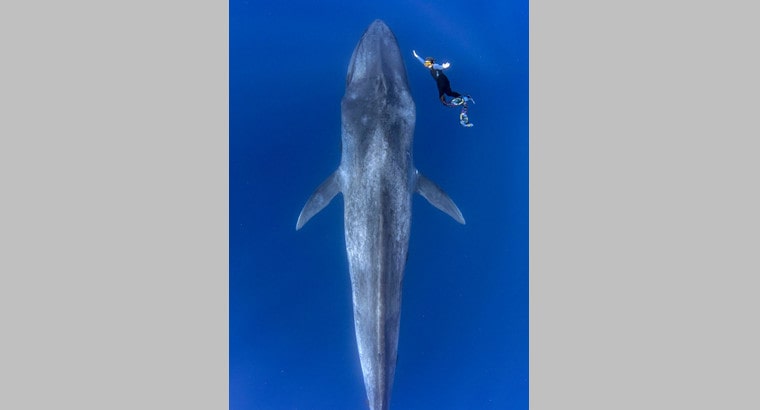
Image source: Pinterest
As mentioned above, the blue whale is the largest animal on the planet, with a maximum length of about 100 feet and a weight of about 200 tons. Its heart alone is the size of a bumper car.
2. Fin Whale
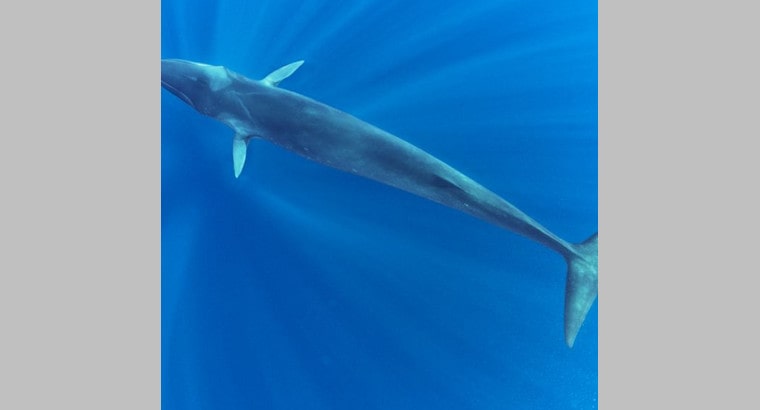
Image source: Pinterest
The Fin whale is the second-largest animal on earth, with a maximum length of about 90 feet and a weight of 105 tons. Its name comes from the discernible fins on its back. Also known as the greyhound of the sea, the Fin whale can travel at a shocking speed of up to 28 mph. This whale consumes up to 4,400 pounds of krill daily.
3. Sperm Whale

Image source: Pinterest
The sperm whale is the largest of the toothed whales and uses sonar to sense its surroundings and hunt prey. Its sound waves are so strong that divers swimming near it feel the pulse.
When the sound bounces off an object or prey and returns to the whale, its brain forms an image based on the signal. This whale, which is a deep diver, can grow up to 60 feet long and weigh about 40 tons.
4. North Atlantic Right Whale

Image source: Pinterest
The North Atlantic right whale can grow up to 60 feet long and weigh up to 70 tons. However, it is one of the highly endangered species of whales. Its current population is estimated to be less than 440 whales. Its main characteristics include a long arching mouth that starts above the eyes and rows of baleen plates hanging on either side of its upper jaws.
5. Bowhead Whale
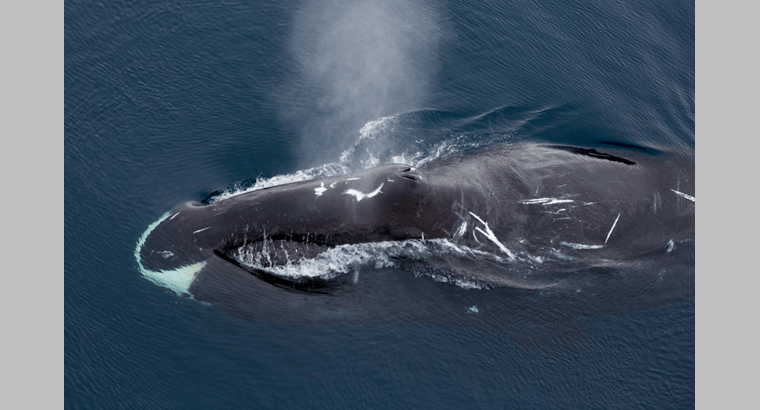
Image source: Pinterest
The bowhead whale is mainly found in the freezing Arctic waters and it’s one of the heaviest animals on the planet – weighing approximately 75-100 tons. This whale can grow up to 60 feet long. Its lifespan is estimated to be around 200 years.


